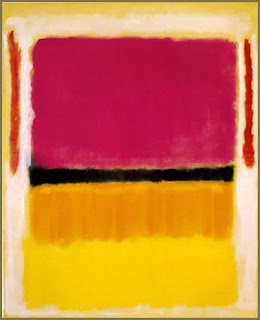Ruth Day
The advent of American abstract expressionist art came at a very fragile time in
The five images below are all examples of American abstract expressionist art created during the 1940s and 50s. As you can see, it is very difficult to interpret this artwork and figure out what the artist was thinking when he created it. Some of these paintings seem to be just pieces of canvas covered in brightly colored paint. The piece by Mark Rothko doesn’t even seem to have much in the way of shapes. Even the title is just a list of colors. Since one of those colors is red, the painting could have been interpreted as communist. Some of the other examples seem to be a morbid and dark in nature. In Kooning’s piece one may be able to make out human forms that are in very violent positions and covered in blood. Of course, others may interpret this work entirely differently. One thing all of these works have in common is the fact that it was believe that only “the elite” could understand and interpret them. For this reason, many Americans were threatened by art like this. Some accused it of being the work of communists while others were just made to feel uncomfortable. In this decade, it may be hard for us to believe that something as innocent as abstract art could be considered dangerous but during the cold war, most Americans were paranoid.
As for the other three images, Barnett’s piece could have been construed as communist, even though that may have been furthest from the artist’s mind when he painted it. The two red bars on a black background may have been interpreted as communist propaganda because red was the color most associated with communism. Reinhardt’s painting can be interpreted in many different ways. I can’t see how it could be considered communist but I do think it looks like it is lying sideways. The vast majority of interpretations that could result from this painting could make it seem threatening to a paranoid country. The only one left, Kline’s painting, seems very dark and mysterious to me. Again, I don’t see how it could be construed as communist but I do interpret it as having a very violent message.
Though some may consider such abstract art to be un-American (and anything un-American must be communist) because of its lack of tradition, “…labeled any deviation from their own esthetic canon, not a matter of taste, but a deviation from their own esthetic canon,” (Mathews, 162), it is obvious that such paintings express very American ideas. They represent freedom of expression and other American liberties, “… this new generation of New York painters ultimately came to be regarded as the embodiment of the kind of freedom denied their colleagues behind the iron curtain, their works celebrated as quintessentially American,” (Mathews, 168). These combating views of modernism led to many debates over whether some artwork should be shown or allowed to continue existence. Eventually, proponents of modernism won over and the paranoia about abstract art subsided.
William de Kooning, "Excavation"
Franz Kline, "Orange Outline"

Barnett Newman, "Adam"

Ad Reinhardt, "Yellow Painting (Abstraction)"






1 comment:
Your point about the obvious paranoia concerning the threat of communism, although mentioned in several other blogs, for some reason made me wonder whether such circumstances could influence our perspectives and interpretations of today's art, literature, music, and other forms of expression. To think that because communism was becoming a prominent battle for America to fight, a genre of art was so undermined by so many individualists who feared the spread of communism seems hard to comprehend in the context of today. Had there been no threat to the United States, would this type of expressionism have arisen? If so, would it have been judged so harshly by traditionalists regardless of whether or not it represented any form of politics? It's strange to think that the threat of terrorism or anything like that today could cause such a national uproar against a form of free expression.
Post a Comment